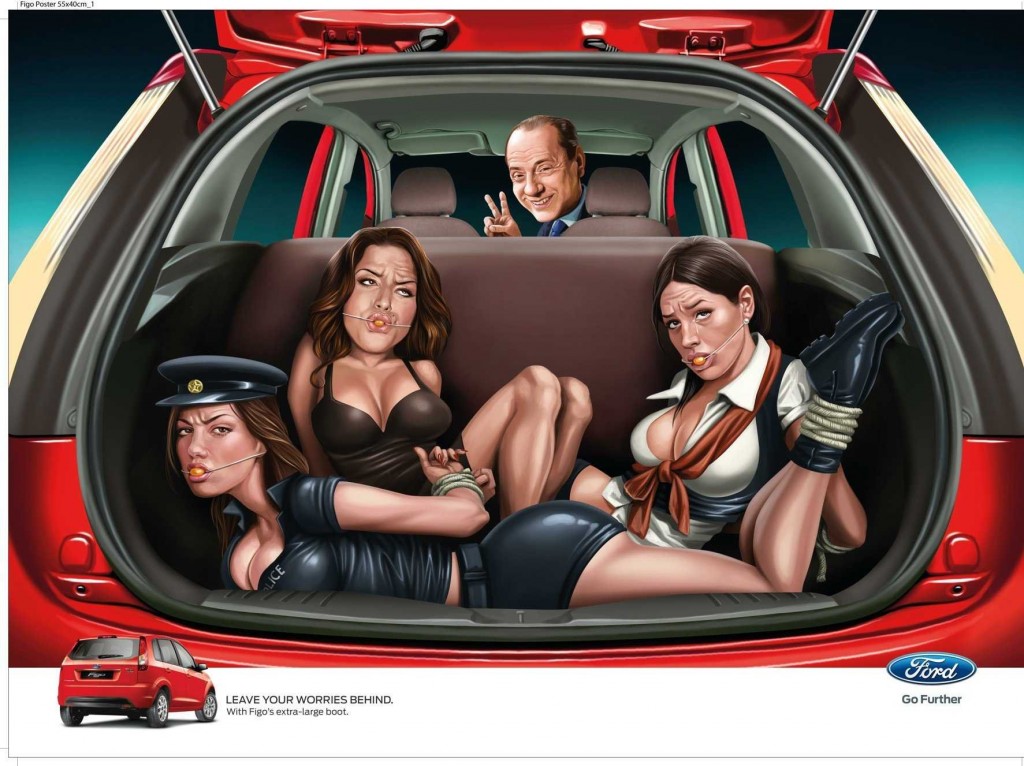
Of late Indian advertising and its ethics have been under the microscope. This cartoon was posted online by JWT India, a branch of one of the world’s largest ad agencies, as part of a series intended to illustrate a small car’s rear storage space, with the tagline: “Leave your worries behind with Figo’s extra-large boot,” After the image rapidly spread online, and prompted a backlash from women’s groups in India, it was withdrawn, along with two other versions of the cartoon ad, which showed the reality television star Paris Hilton using the car to abduct the Kardashian sisters and the Formula 1 driver Michael Schumacher kidnapping three of his rivals.

The ad raised hackles on several moral and ethical grounds. Not only was it very offensive in a country with a highly charged anti-rape atmosphere but also there was the fact that the ad was created for the sole purpose of winning an award, i.e. scam advertising. When ethical questions were raised all around the world, JWT, one the world’s largest ad agencies and the creator of the ad, shed responsibility and fired some top executives.
ASCI AND ITS FUNCTIONING
In India, the regulatory body for advertising, ASCI (Advertising Standards Council of India), addresses complaints about unethical advertising. It has set a code of conduct for advertisers to follow. With ASCI setting broad guidelines for it to follow.
The ASCI code of Advertising Practice is mentioned in 4 Chapters:
Chapter – 1: To ensure truthfulness and honesty of representations and claims made.
Chapter – 2: To ensure that an advertisement is not offensive to the generally acceptable standard of Public Decency.
Chapter – 3: To safeguard against indiscriminate advertisement in situations, or of the promotion of products which are regarded as hazardous or harmful to society or to individuals, particularly minors.
Chapter – 4: To ensure that the advertisement observes fairness in competition
Here is an example of one of the complaints resolved by ASCI. The complaint was against Luminous Water Technologies Pvt Ltd having their product, Livpure RO Water Purifier’s tagline as “Duniya ka sabse shudh pani”. As per the complaint, the TV advertisement of Livpure Water Purifier states that Livpure gives “Duniya ka sabse shudh pani”. Now, Kent Water Purifier’s last campaign was based on the key proposition that Kent provides “Duniya Ka Sabse Shudh Pani”. – definitely, the Livpure ad has taken off in the blaze of the higher-profile Kent product which has been using this tagline in all their communication material since 2011 consistently. This is a blatant copy of the same proposition and a gross violation of brand property committed by Livpure water purifier. It reflects very poorly on the company and the agency who designed the campaign.
The investigation concluded by the ASCI saying that the tagline of Livpure Water Purifier was similar to the tagline of Kent Water Purifier and suggested plagiarism. The advertisement contravened Chapter IV.3 of the Code.
THE SOCIAL MEDIA MINEFIELD
Another emerging minefield of ethics is social media advertising and marketing. The rules here are still to be established and it is jungle law. As a marketer or advertiser, if your brand is taking the social media route, it is best to lay your own ground rules on ethical behaviour. In spite of the rules, there is always enough space for a creative mind to come up with great advertising.
